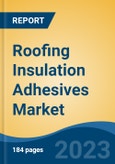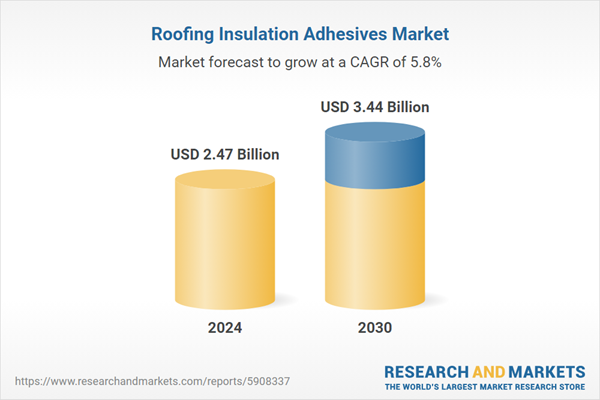Speak directly to the analyst to clarify any post sales queries you may have.
10% Free customizationThis report comes with 10% free customization, enabling you to add data that meets your specific business needs.
Roofing insulation adhesives are instrumental in creating a thermal barrier that prevents heat loss or gain, reducing the energy needed for heating and cooling. The global construction industry is undergoing a sustainability revolution. Green building practices, including energy-efficient roofing systems, are in high demand. Roofing insulation adhesives that are environmentally friendly and contribute to energy savings are integral to this trend. The rising occurrence of extreme weather events, such as hurricanes and heatwaves, underscores the importance of robust roofing systems. Roofing insulation adhesives provide an extra layer of protection against weather-related damage.
Roofing insulation adhesives must be compatible with a wide range of roofing materials, including metal, single-ply membranes, and asphalt shingles. Ensuring proper adhesion and compatibility can be challenging. While the demand for sustainable adhesives is growing, some roofing insulation adhesives may still contain volatile organic compounds (VOCs) or other chemicals that can impact indoor air quality and the environment.
Roofing insulation adhesives are increasingly shifting towards sustainable formulations with low or zero VOC content. This aligns with green building practices and environmental regulations. Integration of smart technologies in roofing systems is on the rise. Roofing insulation adhesives may play a role in the installation of sensors and solar panels, contributing to building energy efficiency. As climate change impacts weather patterns, roofing insulation adhesives that offer improved resistance to extreme weather events and help mitigate climate-related damage are expected to see increased demand.
The global roofing insulation adhesives market is poised for significant growth as the construction industry continues to prioritize energy efficiency, sustainability, and resilience against extreme weather events. Roofing insulation adhesives play a pivotal role in achieving these goals by enhancing thermal performance, ensuring material compatibility, and contributing to the durability of roofing systems. To thrive in this evolving market, adhesive manufacturers should focus on developing sustainable, environmentally friendly formulations and adapting to the changing needs of the construction industry. As the world seeks innovative solutions to combat climate change and reduce energy consumption, roofing insulation adhesives will remain a critical component of energy-efficient and resilient building practices.
Key Market Drivers
Undergoing a Sustainability Revolution is Major Factor for Roofing Insulation Adhesives Market Growth
The global roofing insulation adhesives market is experiencing substantial growth, primarily driven by the ongoing sustainability revolution in the construction industry. The construction industry is undergoing a sustainability revolution, with a growing focus on reducing energy consumption, minimizing environmental impact, and improving the overall efficiency of buildings. Roof insulation is a critical element in sustainable building design. It helps regulate indoor temperatures, reduce heating and cooling costs, and decrease a building's carbon footprint. Under the net-zero emission scenario, demand for critical materials is projected to rise 16-fold by 2050 compared to 2020, highlighting the need for durable, energy-efficient solutions like roofing adhesives in sustainable construction.Roof insulation requires effective adhesives to securely bond insulation materials to roofing substrates. These adhesives play a crucial role in ensuring the insulation's long-term performance and energy efficiency. Roofing insulation adhesives are designed to bond various insulation materials, such as rigid foam boards, fiberglass, and mineral wool, to roofing substrates like metal, concrete, and asphalt.
Sustainable building practices emphasize energy-efficient construction, which includes well-insulated roofs. Properly bonded roofing insulation, facilitated by roofing insulation adhesives, helps reduce heat loss and heat gain, resulting in significant energy savings for building owners. The sustainability revolution calls for reducing the environmental impact of construction projects. Roofing insulation adhesives that enable the efficient use of insulation materials contribute to this goal by reducing waste and energy consumption during a building's lifecycle.
Government regulations and building codes are increasingly incorporating energy efficiency standards. These regulations often require the use of adequate insulation and effective adhesives to meet energy performance targets. Ongoing research and development efforts in the adhesive industry have led to the creation of advanced roofing insulation adhesive formulations. These formulations offer improved adhesion, durability, resistance to environmental factors, and compliance with industry standards. The growing demand for energy-efficient and sustainable building solutions is driving the need for specialized roofing insulation adhesives. Architects, builders, and developers are seeking adhesives that not only meet performance requirements but also align with sustainability goals.
The global roofing insulation adhesives market is experiencing robust growth, primarily driven by the sustainability revolution in the construction industry. Roofing insulation adhesives have become essential components in the quest for energy-efficient and environmentally responsible building practices. As the construction industry continues to prioritize sustainability and energy efficiency, the market for roofing insulation adhesives is expected to thrive. Manufacturers and suppliers in this market must remain at the forefront of technology and innovation to meet the evolving demands of the construction industry, ensuring continued growth and the creation of more energy-efficient and sustainable buildings worldwide.
Key Market Challenges
Material Compatibility with Wide Range of Roofing Materials
Material compatibility with a wide range of roofing materials represents a significant challenge hindering the growth of the global roofing insulation adhesives market. Roofing insulation adhesives play a critical role in ensuring effective insulation and waterproofing in roofing systems. However, the roofing industry is diverse, with various materials like asphalt shingles, metal, concrete, and single-ply membranes used for roofing, each having its unique properties and requirements. Adhesives must be formulated to adhere effectively to these different substrates, ensuring a durable and long-lasting bond. Developing adhesive solutions that offer universal compatibility with this diverse range of roofing materials can be technically demanding and costly. Additionally, the certification and approval processes for these adhesives with various roofing systems can be time-consuming, limiting market entry.To address this challenge and drive growth in the roofing insulation adhesives market, manufacturers must invest in research and development to create versatile adhesive formulations that excel in bonding with a broad spectrum of roofing materials. Collaboration with roofing material manufacturers and industry stakeholders can facilitate the development of standardized solutions, making it easier for roofing professionals to adopt these adhesives across different applications, ultimately spurring market expansion.
Key Market Trends
Smart Roofing Systems
The adoption of Smart Roofing Systems represents a significant trend driving the growth of the global roofing insulation adhesives market. As sustainability and energy efficiency become paramount in the construction industry, roofing systems are evolving to meet these demands. Smart Roofing Systems integrate advanced technologies like sensors, insulation materials, and energy-efficient coatings to optimize a building's energy consumption, thermal performance, and overall comfort. Roofing insulation adhesives play a vital role in Smart Roofing Systems by securely bonding insulation materials and ensuring their long-term effectiveness. These adhesives enhance insulation performance by preventing air leakage and thermal bridging, thus reducing energy consumption for heating and cooling.As governments worldwide implement stricter energy efficiency regulations and building standards, the demand for Smart Roofing Systems and the roofing insulation adhesives that support them is on the rise. Companies in the roofing insulation adhesives market that innovate and provide solutions tailored to Smart Roofing Systems are well-positioned to capitalize on this transformative trend, contributing to more sustainable and energy-efficient construction practices.
Key Market Players
- 3M Company
- Polyglass USA, Inc.
- MAPEI S.p.A.
- Sika AG
- Henkel AG & Co. KgaA
- BASF SE
- Bostik SA
- H.B. Fuller Co.
- Arkema SA
- Apollo Roofing Solutions
Report Scope:
In this report, the Global Roofing Insulation Adhesives Market has been segmented into the following categories, in addition to the industry trends which have also been detailed below:Roofing Insulation Adhesives Market, By Type:
- Acrylic
- Epoxy
- Polyurethane
- Silicone
Roofing Insulation Adhesives Market, By Component Type:
- One Component
- Two Component Electric
Roofing Insulation Adhesives Market, By Curing Process:
- Moisture
- Thermal Cure
- UV Cure
Roofing Insulation Adhesives Market, By Substrate:
- Ceramic
- Concrete
- Wood
Roofing Insulation Adhesives Market, By End User:
- Non-Residential
- Residential
Roofing Insulation Adhesives Market, By Region:
- Asia-Pacific
- China
- India
- Japan
- Australia
- South Korea
- North America
- United States
- Canada
- Mexico
- Europe
- France
- United Kingdom
- Italy
- Germany
- Spain
- South America
- Brazil
- Argentina
- Colombia
- Middle East & Africa
- South Africa
- Saudi Arabia
- UAE
- Kuwait
- Turkey
- Egypt
Competitive Landscape
Company Profiles: Detailed analysis of the major companies present in the Global Roofing Insulation Adhesives Market.Available Customizations:
With the given market data, the publisher offers customizations according to a company's specific needs. The following customization options are available for the report.Company Information
- Detailed analysis and profiling of additional market players (up to five).
This product will be delivered within 1-3 business days.
Table of Contents
Companies Mentioned
The leading companies profiled in this Roofing Insulation Adhesives market report include:- 3M Company
- Polyglass USA, Inc.
- MAPEI S.p.A.
- Sika AG
- Henkel AG & Co. KgaA
- BASF SE
- Bostik SA
- H.B. Fuller Co.
- Arkema SA
- Apollo Roofing Solutions
Table Information
| Report Attribute | Details |
|---|---|
| No. of Pages | 180 |
| Published | September 2025 |
| Forecast Period | 2024 - 2030 |
| Estimated Market Value ( USD | $ 2.47 Billion |
| Forecasted Market Value ( USD | $ 3.44 Billion |
| Compound Annual Growth Rate | 5.8% |
| Regions Covered | Global |
| No. of Companies Mentioned | 11 |









